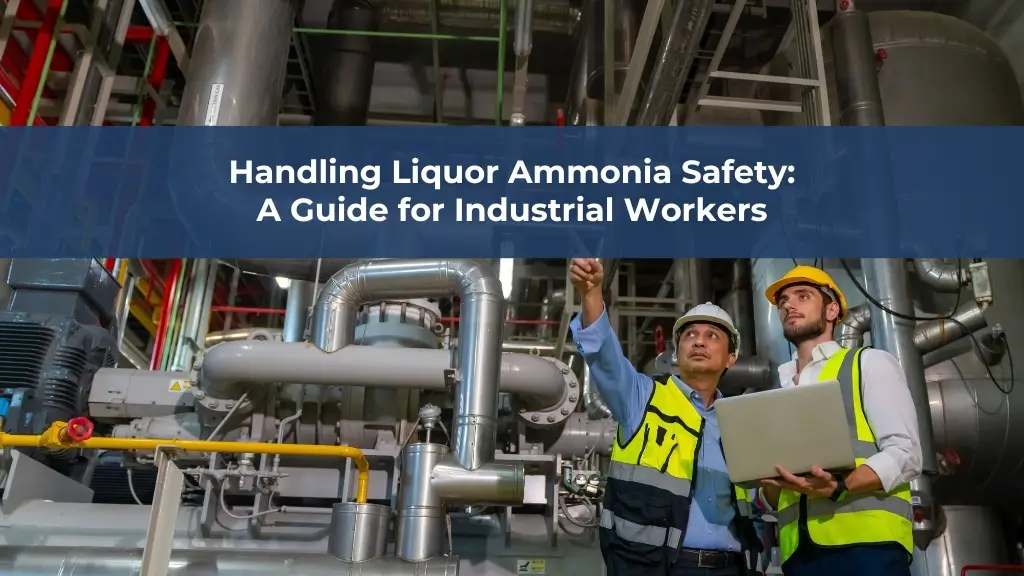Have you ever wondered what makes your refrigerator work? The refrigerant inside it plays a crucial role in keeping your food fresh and cool. The commonly used refrigerant in the refrigeration industry is Ammonia. This article will provide a closer examination of ammonia, its properties, functioning, and importance in the refrigeration industry in India.
Ammonia, also called R717, has been used as a refrigerant since the early 20th century and is a naturally occurring gas. It can be easily liquefied under pressure and is highly pungent but colorless. Large commercial and industrial refrigeration systems widely use ammonia due to its high efficiency. The significance of Ammonia in the Indian refrigeration industry cannot be emphasized enough.
Ammonia is now a preferred option to conventional refrigerants due to the surge in demand for environmentally friendly and energy-efficient refrigeration systems. This article will cover the properties of ammonia, its functioning as a refrigerant, and the advantages and disadvantages linked to its use.
Properties of Ammonia as a Refrigerant
Ammonia has unique physical and chemical properties that make it an effective refrigerant. Its boiling point is -33.34°C and its critical temperature is 132.5°C. These properties allow Ammonia to efficiently absorb and release heat, making it an ideal refrigerant for large commercial and industrial refrigeration systems.
Ammonia offers a major benefit as a refrigerant due to its high energy efficiency. Ammonia can absorb a significant amount of heat due to its high latent heat of vaporization when it transitions from a liquid to a gas state. This leads to a more efficient refrigeration process, which can result in energy savings and decreased operating expenses.
Another advantage of Ammonia is its low environmental impact. Unlike synthetic refrigerants like HFCs and HCFCs, Ammonia is a naturally occurring gas that does not contribute to the greenhouse effect. Thus, it presents an appealing choice for individuals and businesses seeking to diminish their carbon footprint and advance sustainability.
However, Ammonia also has some disadvantages. It is highly toxic and flammable, making it a safety concern when used as a refrigerant. Proper handling and storage procedures must be followed to ensure the safety of those working with Ammonia.
How does Ammonia work as a Refrigerant?
The process of the refrigeration cycle enables a refrigerant to absorb heat and transfer it to the outside environment. Ammonia, for instance, follows a refrigeration cycle comprising four primary components: compressor, condenser, expansion valve, and evaporator.
The refrigerant undergoes compression and heating in the compressor, resulting in its transformation from a low-pressure gas to a high-pressure gas. The high-pressure gas then passes into the condenser, where it discharges its heat to the outside environment and changes into a liquid.
The liquid refrigerant then flows through the expansion valve, where its pressure is reduced. The high-pressure liquid refrigerant transforms into a low-pressure gas, which proceeds towards the evaporator where it absorbs heat from the refrigeration system’s interior.
The refrigeration cycle then repeats, with the refrigerant flowing back to the compressor to start the process again. This continuous cycle allows the refrigerant to transfer heat from the inside of the refrigeration system to the outside environment, keeping the inside cool.
Ammonia is a refrigerant that offers higher energy efficiency and lower environmental impact, providing a more sustainable and cost-effective refrigeration solution compared to other refrigerants. These advantages make it a more appealing choice for those who seek to avail such benefits.
Safety Concerns with Ammonia Refrigeration
A safety concern arises when using Ammonia as a refrigerant due to its toxicity and flammability. It is important to handle and store Ammonia properly to ensure the safety of those working with it.
Following proper handling procedures, such as wearing protective clothing, using sufficient ventilation, and storing Ammonia in a well-ventilated area away from ignition sources, is crucial to ensure its safe and responsible use. Furthermore, compliance with safety measures and regulations is essential for maintaining its safe usage.
Ammonia in Indian Refrigeration Industry
A popular refrigerant choice in the Indian refrigeration industry is Ammonia, as an increasing number of commercial and industrial refrigeration systems utilize it owing to its high energy efficiency and low environmental impact. Therefore, it is widely considered a more sustainable and cost-effective solution for those seeking such benefits.
However, there are still challenges facing the adoption of Ammonia as a refrigerant in India. A major obstacle to the adoption of Ammonia as a refrigerant is the inadequate awareness and knowledge of its benefits. Moreover, a lack of technical expertise in the field further complicates the matter for some businesses to incorporate Ammonia into their refrigeration systems.
Despite these challenges, the future of Ammonia as a refrigerant in India looks promising. Ammonia is expected to gain popularity as demand for eco-friendly and energy-efficient refrigeration systems rises.
Advantages of using Ammonia as a Refrigerant
Ammonia has advantages over traditional refrigerants, making it a more sustainable and cost-effective option.
Some of the key advantages of using Ammonia as a refrigerant include:
- Energy efficiency: Ammonia has a high latent heat of vaporization, enabling it to absorb a significant amount of heat during its liquid-to-gas phase transition. This results in a more efficient refrigeration cycle, which can save energy and reduce operating costs
- Environmental impact: Unlike synthetic refrigerants like HFCs and HCFCs, Ammonia is a naturally occurring gas that does not contribute to the greenhouse effect. This appeals to those seeking to reduce their carbon footprint and promote sustainability
- Cost-effectiveness: Ammonia is a cost-effective option for large commercial and industrial refrigeration systems due to its high efficiency as a refrigerant. Ammonia’s efficiency can translate into decreased operating expenses and energy consumption, ultimately resulting in long-term cost savings
Applications of Ammonia as a Refrigerant
Ammonia is widely used in a variety of refrigeration applications, including:
- Commercial refrigeration: Ammonia is a preferred option for large commercial refrigeration systems like supermarkets and cold storage facilities. The combination of high energy efficiency and minimal environmental impact make ammonia a compelling choice for individuals seeking a sustainable and cost-effective solution
- Industrial refrigeration: Ammonia is a safe and popular choice for large-scale industrial refrigeration in food, pharmaceutical, and chemical manufacturing due to its efficiency
- Residential refrigeration: While not as common as in commercial and industrial applications, Ammonia is also used in some residential refrigeration systems. The combination of high efficiency and minimal environmental impact makes it an appealing choice for individuals seeking a sustainable and economical solution
Future of Ammonia as a Refrigerant
The future of Ammonia as a refrigerant looks promising, with the growing demand for energy-efficient and environmentally-friendly refrigeration systems. Ammonia refrigeration systems are expected to become more attractive to businesses and consumers as technology improves their efficiency and safety.
Government regulations are also expected to play a role in the future of Ammonia as a refrigerant. As countries implement policies to decrease greenhouse gas emissions, Ammonia is anticipated to become a more prevalent and eco-friendly substitute for conventional refrigerants.
Comparison with Other Refrigerants
Ammonia is often compared to other refrigerants, including HFCs and HCFCs, CO2, and Propane.
Some of the key differences between Ammonia and these other refrigerants include:
Compared to Ammonia, HFCs and HCFCs are synthetic refrigerants that contribute to the greenhouse effect and are less efficient. This makes them a less attractive option for those seeking sustainable and cost-effective solutions.
CO2, a gas that occurs naturally, is a commonly used refrigerant. While it is more environmentally friendly than synthetic refrigerants, it is less efficient than Ammonia and is typically only used in smaller refrigeration systems.
Propane, a combustible gas, is frequently utilized as a refrigerant in residential refrigeration systems. While it is a more cost-effective option than Ammonia, it is less efficient and has a lower latent heat of vaporization, making it a less attractive option for larger commercial and industrial refrigeration systems.
Challenges in Adopting Ammonia as a Refrigerant
While Ammonia offers several advantages over traditional refrigerants, there are still challenges facing its adoption. Some of the main challenges include:
- Lack of awareness and knowledge: Many businesses and consumers are not aware of the benefits of using Ammonia as a refrigerant, making it difficult to increase its adoption rate
- Technical expertise: There is a shortage of technical expertise in the field of Ammonia refrigeration, making it difficult for some businesses to adopt it as a refrigerant. This lack of expertise can also make it more challenging to maintain and repair Ammonia refrigeration systems
- Availability and accessibility: Ammonia’s availability is more limited compared to other refrigerants, despite its widespread use in the refrigeration industry. This can make it more challenging to obtain and use Ammonia as a refrigerant, particularly in remote areas
Conclusion
In conclusion, Ammonia is a highly efficient and environmentally-friendly refrigerant that offers several advantages over traditional refrigerants. The benefits of high energy efficiency, minimal environmental impact, and cost-effectiveness make it an appealing option for those seeking a sustainable and economical refrigeration solution.
Despite the challenges facing its adoption, the future of Ammonia as a refrigerant looks promising. The increasing demand for environmentally friendly and energy-efficient refrigeration systems is likely to drive the adoption of ammonia in the forthcoming years.














